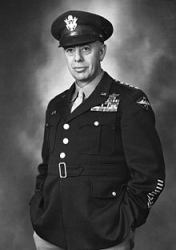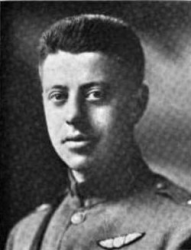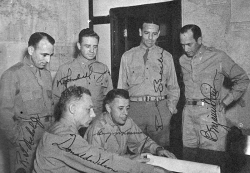
 |
|
|
||
|
George Churchill Kenney |
||||
|
Engagements: • World War I (1914 - 1918)• World War II (1941 - 1945) |
||||
| Biography: | ||||
|
George Churchill Kenney George Churchill Kenney was born on 6 August 1889 in Yarmouth, Nova Scotia, Canada, grew up in Brookline, MA, and graduated from Brookline High School in 1907. He attended the Massachusetts Institute of Technology intermittently from 1907 to 1911, but left MIT after three years to take a job at Quebec Saguenay Railroad as an instrument technician. Military Career In June 1917 he enlisted as a flying cadet in the Aviation Section, U.S. Signal Corps, where he received flight training from noted aviator Bert Acosta. He was commissioned as a First Lieutenant in December 1917 and was immediately sent to Advanced Flying Training School in France. Upon successful completion of the course in February 1918, he was assigned to the 91st Aero Squadron. Kenney flew 75 combat missions in 16 months and was credited with downing two enemy planes. (It is believed that one of the two German pilots he shot down was Hermann Göring, later the head of the Luftwaffe in World War II.)In March 1919, Kenney was promoted to Captain and appointed Commanding Officer of the 91st Aero Squadron. He remained with the occupation forces in Germany after cessation of hostilities until June 1919 when he was sent to the United States and reassigned to the 8th Aero Squadron at McAllen, TX. In 1926, Kenney was sent to the Air Corps Tactical School at Langley Field, VA, and completed the course in the middle of that year. He next attended the Command and General Staff College at Fort Leavenworth, KS. Following his successful completion of the course at Fort Leavenworth, Kenney served in a variety of assignments. He was an instructor at the Air Corps Tactical School at Langley Field; he made a survey of potential airfield locations in Puerto Rico and the U.S. Virgin Islands, selecting sites which are in use today. He attended the Army War College in Washington, DC, graduating in 1933. In March of 1935, Captain Kenney was promoted to Lieutenant Colonel, skipping over the rank of Major. In 1939, Lieutenant Colonel Kenney Commanded the Air Corps Experimental Division and Engineering School at Wright Field, OH. In March 1940, Kenney was promoted to Colonel and sent to France as U.S. Assistant Military Attaché for Air to observe Allied air operations during the early stages of World War II. As a result of his observations and recommendations, a number of improvements were made in United States military aircraft over a year prior to our entry into World War II. Kenney was promoted to Brigadier General in January 1941 and promoted to Major General in February 1941. World War II In March 1942, Major General Kenney was assigned to the West Coast as Commanding General of the 4th Air Force. In August 1942, MG Kenney took over Command of both the Allied Air Forces in the SWPA (South West Pacific Area) and the newly-formed U.S. Fifth Air Force, thereby becoming the senior Allied Air Officer under overall Theater Commander General Douglas MacArthur. He was promoted to Lieutenant general in October 1942. Initially from his headquarters in Brisbane, Australia, and later from New Guinea and the Philippines, LTG Kenney commanded American, Royal Australian Air Force, British Royal Air Force and Dutch air units. For three years he directed the air war against Japanese positions in and around New Guinea (including the surrounding islands), the Dutch East Indies, Borneo, and the Philippines. In one of the classic engagements of the war, the Battle of the Bismarck Sea in early March 1943, LTG Kenney planned and directed the attack of B-17 bombers that sank 16 Japanese vessels in a convoy with only a minor loss of participating U.S. aircraft. The loss of most of this huge armada, which was loaded with supplies and troop reinforcements, ended Japanese hopes of retaining control of New Guinea. In 1944, LTG Kenney was appointed Commander of the revived U.S. Far East Air Force (FEAF), which came to include the Fifth, Thirteenth, and Seventh Air Forces. After the liberation of the Philippines, units under Kenney's command took part in the battles of Iwo Jima and Okinawa. Kenney was promoted to the four-star rank of General on 9 March 1945. The C-46 and C-47 transport aircraft of the FEAF were the first American planes to land in Japan following the Japanese surrender on 2 September 1945. Post-War Service After the war, in December 1945, General Kenney was assigned to the Military Staff Committee of the Joint Chiefs of Staff, and was sent to London for the duration of the United Nations Conference. He continued with the Military Staff after his return to the United States in March 1946. In April 1946, he was designated Commanding General of Strategic Air Command, with headquarters at Andrews Air Force Base, MD. On 15 October 1948, General Kenney assumed the position of Commander, Air University, where he remained until his retirement from the Air Force on 31 August 1951. Medals, Awards and Badges Distinguished Service Cross with Bronze Oak Leaf Cluster He was also made a Knight of the British Empire. * During the early period of American involvement in World War II (7 December 1941 – 22 September 1943), the Purple Heart was awarded both for wounds received in action against the enemy and for meritorious performance of duty. With the establishment of the Legion of Merit, by an Act of Congress, the practice of awarding the Purple Heart for meritorious service was discontinued. Distinguished Service Cross Citation The President of the United States of America, authorized by Act of Congress, July 9, 1918, takes pleasure in presenting the Distinguished Service Cross to First Lieutenant (Air Service) George C. Kenney, United States Army Air Service, for extraordinary heroism in action while serving with 91st Aero Squadron, U.S. Army Air Service, A.E.F., near Jametz, France, 9 October 1918. First Lieutenant Kenney gave proof of his bravery and devotion to duty when he was attacked by a superior number of aircraft. He accepted combat, destroyed one plane and drove the others off. Novembers, he continued his mission and enabled his observer to secure information of great military value. General Orders: War Department, General Orders No. 13 (1919) Distinguished Service Cross Citation - Synopsis Lieutenant General George Churchill Kenney (ASN: 0-8940), United States Army Air Forces, was awarded a Bronze Oak Leaf Cluster in lieu of a Second Award of the Distinguished Service Cross for extraordinary heroism in connection with military operations against an armed enemy while serving as Commanding General of the FIFTH Air Force, in aerial combat against enemy forces from 23 July 1942 through 8 January 1943, in the Southwest Pacific Area. Lieutenant General Kenney's gallant leadership and heroic actions are in keeping with the highest traditions of the military service and reflects great credit upon himself, the 5th Air Force, and the United States Army Air Forces. General Orders: Headquarters, South West Pacific Area, General Orders No. 5 (January 11, 1943) In Retirement After his retirement, Kenney lived in Bay Harbor Islands, FL. General Kenney continued to serve military affairs, and the nation, as president of the Air Force Association, in 1954, and as an official with national charities. Kenney wrote three books about the SWPA air campaigns he led during World War II. His major work was General Kenney Reports, a personal history of the air war he led from 1942-45. He also wrote The Saga of Pappy Gunn and Dick Bong: Ace of Aces, which described the careers of two of the most prominent airmen under his command (P-38 pilot Major Richard I. Bong remains the top-scoring American ace of all time, having shot down 40 Japanese planes). Death and Burial General George Churchill Kenney died on 9 August 1977 in Bay Harbor Islands, FL. He is buried at Arlington National Cemetery in Arlington, VA, in Section 30, Grave 398. He was survived by five sons and one daughter. |
||||
| Honoree ID: 759 | Created by: MHOH | |||
Ribbons
Medals
Badges
Honoree Photos
 |  |  |
 |  |
 |


